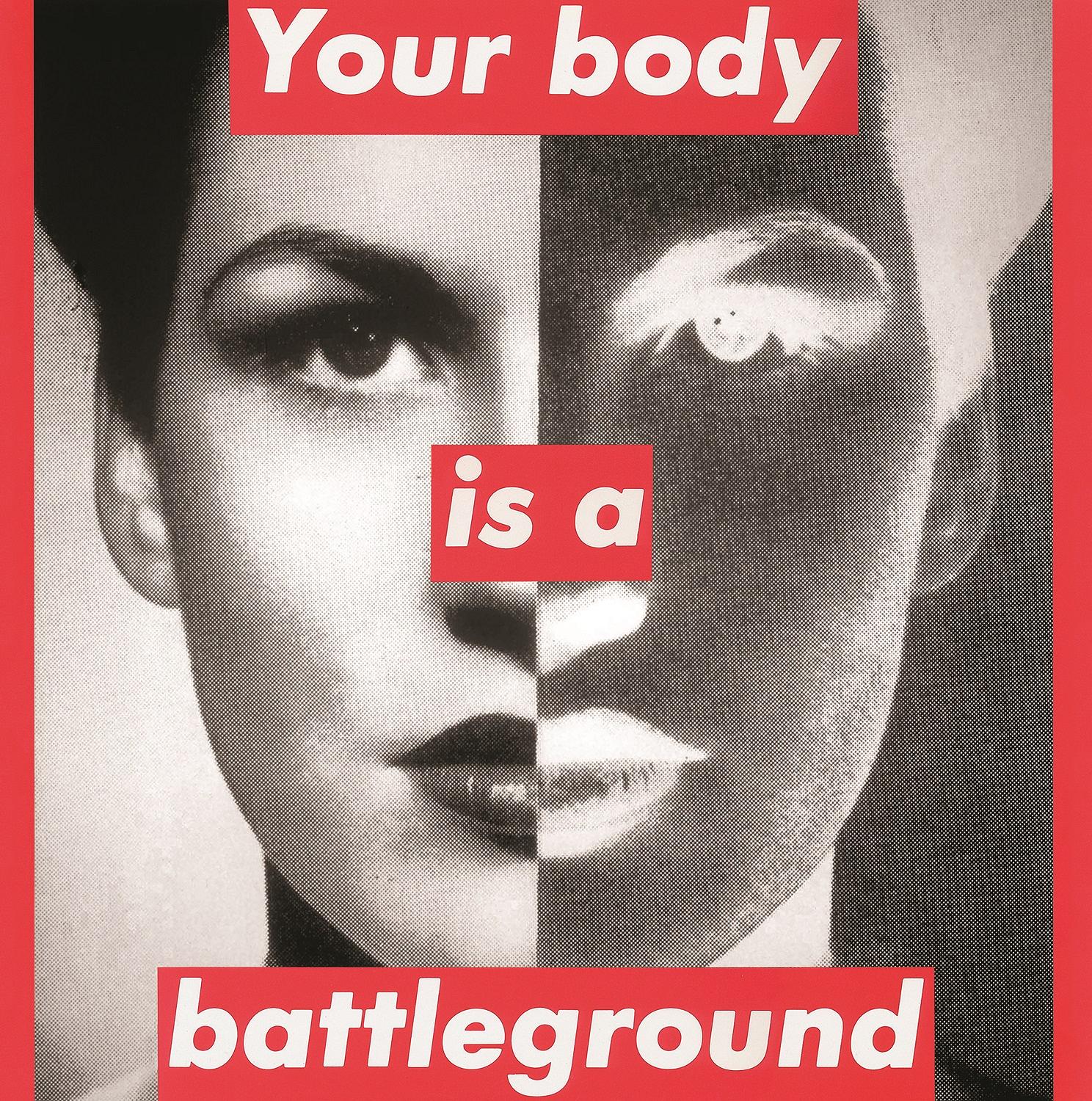What started out as a protest poster rejected by the organisers of a women’s-rights march on Washington DC in 1989 went on to become an iconic 20th-century artwork. Transcending politics, national borders and the logistics of fly-posting, Barbara Kruger’s “Untitled (Your Body Is a Battleground)” is now an internationally recognised call to arms for social justice in all its diversity. This is the story of the making of an American masterpiece.
The New York art world
Barbara Kruger: In New York when I first was coming up in the late 1970s and early 1980s, the art world consisted of 12 white guys in Lower Manhattan. There were plenty of others making work all over the city — people of colour and women. But we were pretty much invisible to that art world. Fortunately, I did meet other people who were incorporating photography into their practice and had similar cultural understandings of how media can make us who we are. And how we can work to resist that.
Cindy Sherman: I met Barbara shortly after I moved to New York in the late ’70s. I was working as the receptionist at Artists Space, and most of the art world came through there at some point. We would mostly see one another at openings, parties and music and film events — many artists were also musicians and filmmakers. We definitely hung out with the same crowd. As we both gradually gained success, we would often compare notes about how it was going for each of us, dealing with other artists, galleries, figuring out who pays for what and so forth.
Iwona Blazwick: After the rather austere conceptual art of the 1970s, painting had made a big comeback in the 1980s, but there were artists in New York, like Barbara and Cindy, who used photography and other media. That was quite radical, because photography had been sidelined to being something documentary.
Cindy Sherman: Women artists of our generation were extremely supportive of one another; there was very little animosity or competitiveness. We saw ourselves as outside the mainstream art world, so we were united in our own corner of it, working with photography, since it wasn’t considered a “high” art form.
Iwona Blazwick: The art critic Rosalind Krauss finally put the nail in the coffin of modernism, demolishing the idea of the genius and the phallic paintbrush to propose a new, heterogeneous art world. As did critics like Hal Foster and Craig Owens, who was a very, very close friend of Barbara’s and was among the first to speak openly about a gay aesthetic. So it was a tremendously exciting, political time, and Barbara and her work were at the heart of it.
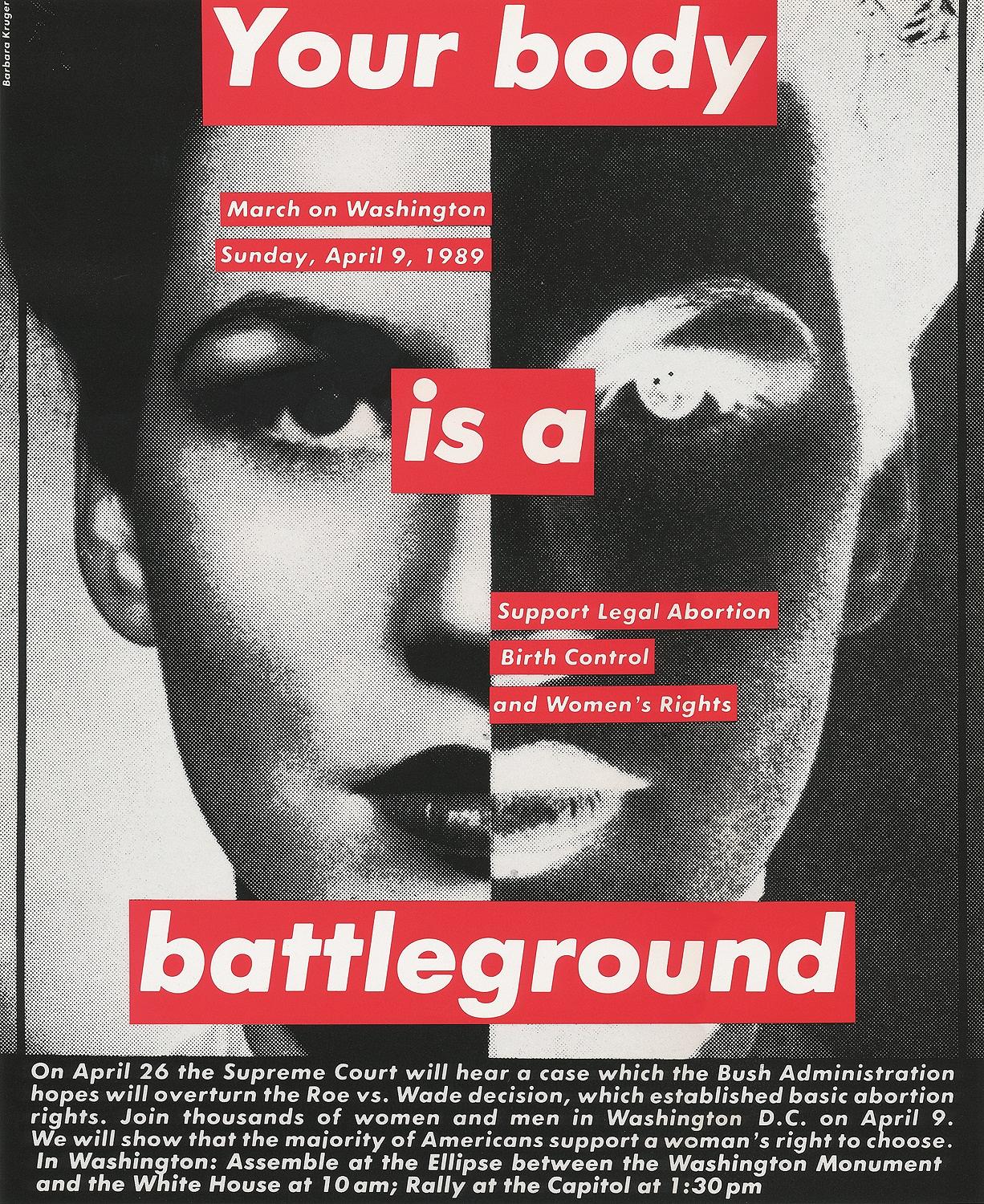
The poster: The original “Untitled (Your Body Is a Battleground)”, designed for the 9 April 1989 abortion-rights march on Washington. Opening image, The artwork: “Untitled (Your Body Is a Battleground)”, 1989. Photographic silkscreen on vinyl, 284.5 × 284.5 centimetres. In the collection of the Broad, Los Angeles.
Making the poster
Barbara Kruger: I went to so many marches in Washington DC over the years, whether it was about women’s issues or the war in Vietnam. The only times I ever visited Washington DC were for a march or demonstration. Was I an activist? It’s hard for me to deal with labels; I was aware of who owns what, who speaks and who is silenced. That’s the broadest way to put it. So I decided to make a poster for the women’s march in 1989, which had been organised because the Republicans were trying to overturn Roe vs Wade. This was yet another instance where we thought we had won the battle, but clearly this is an ongoing struggle that continues to threaten women’s bodies.
Elizabeth Nash: Roe vs Wade overturned a prohibition that started in the 1840s in some states, and significantly, it brought abortion into the medical system. But by 1989 it still wasn’t part of healthcare. It had been siloed away from family planning and reproductive healthcare services, making abortion clinics targets for harassment, vandalism, arson and, in some cases, shootings. From 1989 to 1991 there was a palpable feeling in the US that abortion rights were going to be overturned.
Barbara Kruger: I approached Planned Parenthood and the National Abortion Rights Action League to see if I could collaborate with them. They replied that they had already hired an ad agency. At that time, none of these groups had any experience working with artists. They probably thought, Who is this person calling us? So I figured, OK, I’ll just do it on my own.
Iwona Blazwick: In the 1970s there was a kind of puritanism about feminism. Its art often wasn’t very good to look at. By contrast, Barbara’s work was so seductive. She used ravishing images in a way that was slightly reminiscent of punk collage and the cut-up aesthetic developed by people like Jamie Reid, for the Sex Pistols.
Barbara Kruger: All of my years working as a graphic designer at Condé Nast magazines taught me how to make effective, economic visual deliveries, so it just became a fluency of mine.
Vince Aletti: When I first saw her work, I thought Kruger was an extremely savvy graphic designer, which, of course, she was. There’s no question she would have been aware of the photomontage work of John Heartfield, Hannah Höch, Erwin Blumenfeld and Aleksandr Rodchenko.
Barbara Kruger: I made “Your Body Is a Battleground” in my rented loft on Leonard Street in TriBeCa in New York, a loft that I later got thrown out of because of the rising prices of Manhattan real estate. I’d always collected images from magazines and manuals and had piles of them in plastic envelopes. And I would go through them and see what would help make meaning with a certain textual accompaniment.
David Crowley: She uses the typeface Futura, designed by Paul Renner in the 1920s, so there’s a slight echo of Bauhaus and typophoto.
Vince Aletti: But her work had a lot more in common with Paul Rand, Herbert Matter and Alexey Brodovitch. Barbara was going for that high-impact graphic punch that made a great magazine cover or spread, condensed and kicked up a notch so it worked as a street poster — and eventually, way beyond.
David Crowley: You’re not looking at just a photograph but a reproduction of a printed image — it’s a remediation of an already mediated image. She’s really commenting not just on images but on their mediation.
Barbara Kruger: I don’t remember where the image of the woman with a bisected face came from, but I used it to create a work which was part of a discourse about vulnerability, about bodies, and in this case women’s bodies, but also about ageing and the failures of the American medical system.
David Crowley: It’s an uncompromising image, so it feels like propaganda. That sharp divide down the middle is asking: Where do you stand? And I find it interesting that the words declare “Your body” but it emphasises the face. There’s a disruption going on there. And does it address men and women differently? It’s unsettling.
“My students and I put the posters up all over the city. It was called sniping — a scary term for such a benevolent but still clandestine activity.”
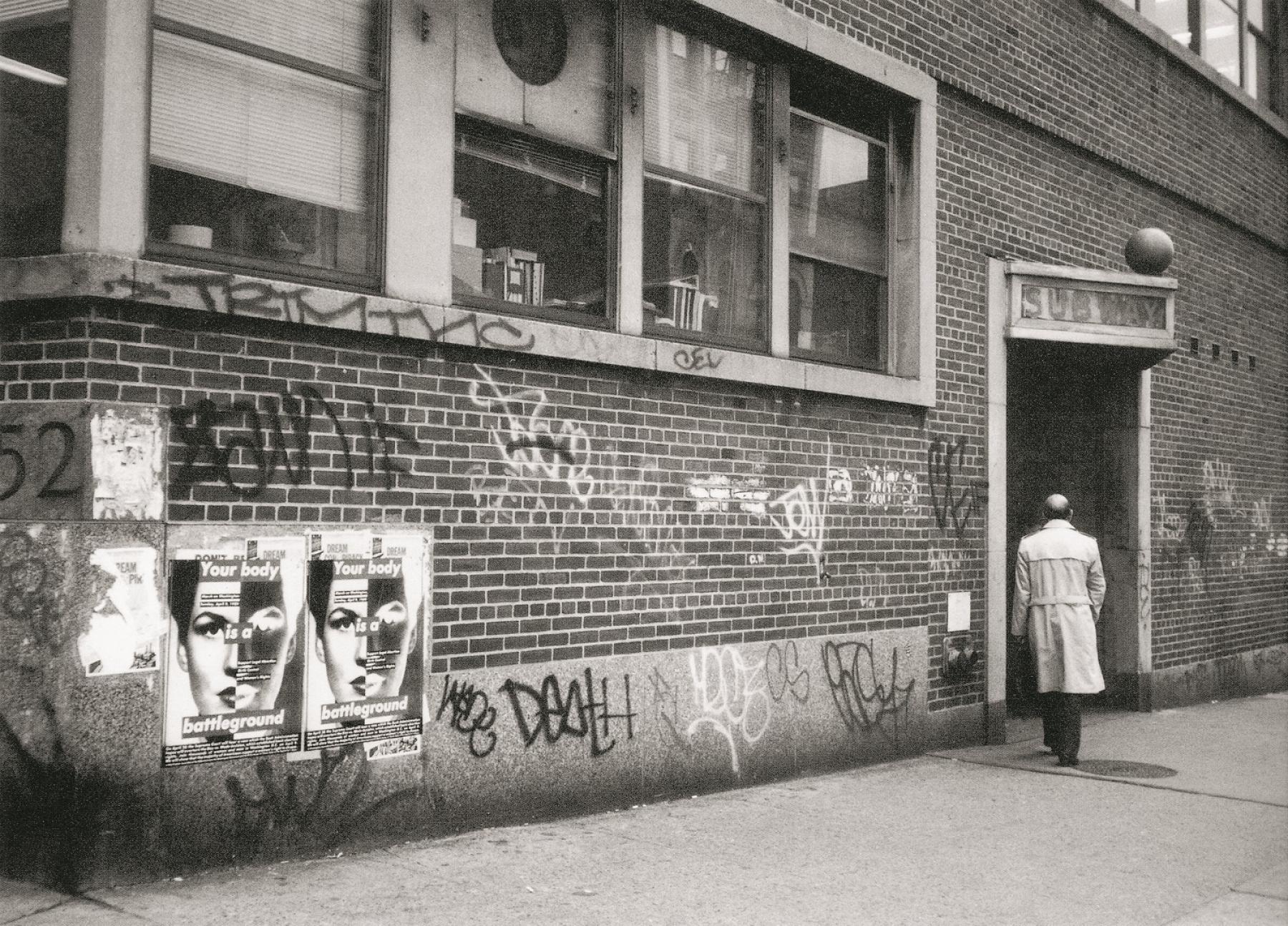
The campaign: “Untitled (Your Body Is a Battleground)” poster fly-posted in New York City, 1989.
Sniping
Barbara Kruger: I had the poster printed at a printer on West 12th Street. At that time it was a desolate postindustrial terrain offering cheap rent to small businesses. I was teaching that semester on the Whitney Independent Study Program. So my students and I went out late at night, and we just put the posters up on construction sites all over the city. At that time there were so many boarded-up sites, and there was a culture of postering for clubs, for music, everything. It was called sniping — a scary term for such a relatively benevolent but still clandestine activity. A group of snipers would put up posters for music venues, like Irving Plaza or Area, but they were soon covered up by other events competing for the posting space. But I figured, why not use that space for other kinds of messages?
Iwona Blazwick: To take art directly to the streets and to use the spaces of advertising, it was definitely part of the ethos of that moment. And the poster was so punchy and beautiful.
Vince Aletti: New York was full of pasted-up posters in the ’80s and ’90s. They’d all come after Keith Haring’s hit-and-run subway drawings from 1980 to ’85, Basquiat’s SAMO bulletins from 1977 to ’80, and a ton of wild graffiti, so they had a lot to live up to.
Shepard Fairey: I come from a skateboarding and punk rock background where subversive appropriation was part of the vernacular, so I got Barbara Kruger’s critique of Americana and advertising. Bands like the Clash and the Dead Kennedys, and then later Public Enemy, were using music to say something socially, and I was craving that in fine art, but it didn’t really exist. Barbara Kruger was one of the few exceptions.
Barbara Kruger: I don’t care if people thought the posters were art or not — I preferred if they didn’t. It’s not like I had my name on them. We put the posters up, and then not long afterwards they were gone.
Cindy Sherman: “Your Body Is a Battleground”, like all of Barbara’s work, has always been right on target with what was happening around us and to us at that time. Her work zeroed in on social politics in a way that functioned very much like advertising, amazing for its time — seductive and nostalgic in its visuals, yet stinging, with a text that shoved it through you.
David Crowley: And can she turn a phrase! Kruger makes up slogans that feel like they’re clichés, but they’re often of her own coinage. “Your Body Is a Battleground” has the capacity to be both familiar and new at the same time.
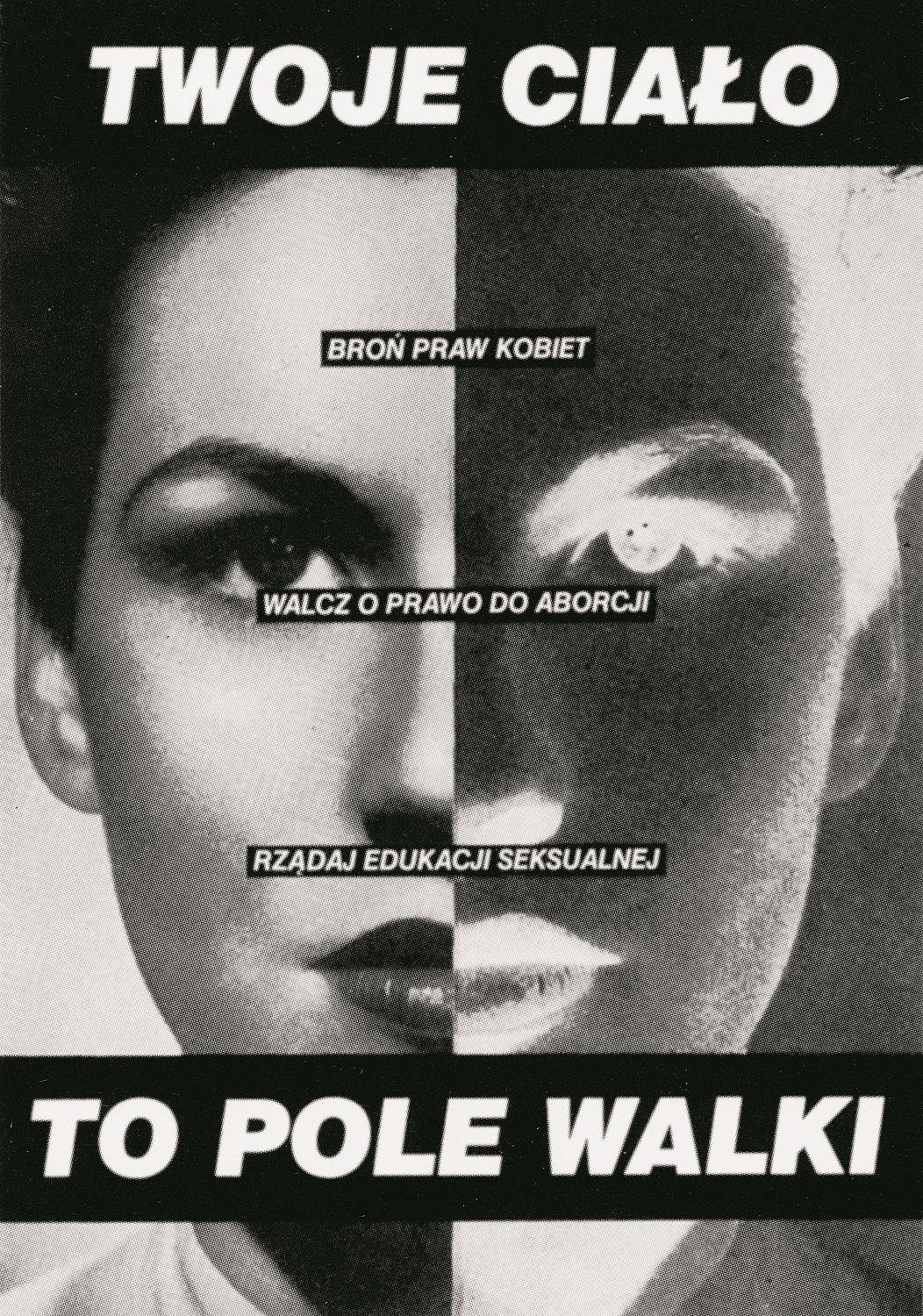
The translation: Polish-language edition of “Untitled (Your Body Is a Battleground)” (1989), made in 1991 for the Ujazdowski Castle Centre for Contemporary Art, Warsaw.
Disseminating the image
Monika Sprüth: In 1989, I was producing the third and final edition of my magazine, Eau de Cologne, which I made in collaboration with artists like Barbara Kruger, Cindy Sherman and Jenny Holzer, and I included a full-page image of “Your Body Is a Battleground”. To mark the magazine’s publication, I decided to wallpaper my whole booth at the Art Cologne art fair with just Barbara’s abortion poster. There was no other art in the booth and nothing for sale except the magazine.
Philomene Magers: I remember that! I was only a teenager then, but I thought it was the coolest statement booth that I’d seen ever. Monika was walking around the fair handing out issues of Eau de Cologne wearing this black hand-knitted dress by Rosemarie Trockel that had brown Woolmarks on the breasts.
Monika Sprüth: It was at Art Cologne that many European artworld professionals and members of the public first saw “Your Body Is a Battleground”.
Barbara Kruger: If it wasn’t for Monika, we — Cindy Sherman, Jenny Holzer, Louise Lawler, Rosemarie Trockel and I — would not have had the visibility that we had in Europe.
Iwona Blazwick: Monika is a real pioneer in terms of promoting female artists, because none of the galleries showed female artists at that time, none of the commercial galleries. Monika was one of the first. It’s just shocking when you think about it.
Monika Sprüth: Barbara has always been an artist who does public projects; there were many other public displays of the poster back then. There was a worldwide feminist movement happening, and I’m sure she was asked many times by many people in many different places for permission to show the poster. That was one of the points of the project: to create something public, not a commercial work of art.
Robyn Farrell: Disseminating the poster was sort of like a mass effort. Somebody could have printed it and shown it on the street in Latin America, for example. The image was radical not only in what it was saying but in the way it was circulated almost entirely outside the art world and outside museums.
Barbara Kruger: One of the cities which displayed the poster early on was Warsaw, Poland, in 1991. I’d been invited to do a project by a space called the Castle.
David Crowley: I was living in Poland in the early 1990s, when it was still communist, and the Ujazdowski Castle Centre for Contemporary Art was a real bridgehead at the end of communism between art in the rest of the world and Poland. I was teaching in art schools then, and Kruger’s work was a complete touchstone for what was happening in the world.
Milada Ślizińska: When Solidarity came to power in 1989, all of a sudden, the rules against sexual education and abortion became stronger and stronger. The political climate had unexpectedly turned against women’s rights, so I asked Barbara to work with us. This is where our problems started.
Barbara Kruger: I usually don’t like to go to places as a kind of tourist and make pronouncements through my work; I’m wary of that kind of tourism as an artist. But at the same time, I knew of the struggles around reproductive rights for Polish women, and I knew that with the rise of Solidarity and its ties to the Catholic Church, women’s rights were starting to be threatened.
Milada Ślizińska: The Castle’s budget came from the minister of culture, and our director was too scared to fund the printing and distribution of Barbara’s poster. I also wanted Barbara to come to Warsaw, and normally the American embassy would help fund such cultural exchanges. But Barbara was a strong critic of President Bush, and she said, “No way. There’s no chance I will let the American embassy pay for my ticket.” So I found a little trick: I realised that if I invited her to come and give a lecture in Warsaw we could use our budget to pay for that.
Barbara Kruger: I eventually gave a talk at the Castle, and I also met up with a number of women in Warsaw and we discussed the situation there. I just felt there was some kind of equivalence with the situation in the United States and the denial of access to women’s health.
Milada Ślizińska: Then I got a very small grant from a Polish-Austrian foundation which allowed us to print 1,000 copies of “Your Body Is a Battleground” and to pay for distribution of 500 of them on city streets and in the subway. We put the other 500 in storage. But the display only lasted one weekend, and then the posters were all torn down — they were either covered with other posters or just torn from the wall. Six months later, I had a phone call from a Polish feminist group who said that they would be happy to distribute the poster again. And they did it in a very smart way, because they put the poster very high up on walls, so there was no way you could tear it down without a very, very high ladder. So the poster had a second life in Warsaw half a year after we first displayed it. This poster really entered the art history of Poland.
David Crowley: I managed to get one of the original Polish posters and brought it back to the UK. I think Kruger wanted the work to travel, so I felt like I was doing something that was somehow in tune with that intention. It’s now in the V&A’s collection.
Milada Ślizińska: I never thought that this little project would have such a strong influence on new generations. In 2014, over 20 years later, it became the main display in a show organised by young curators at the new Museum of Modern Art in Warsaw, which was called Your City Is a Battleground.
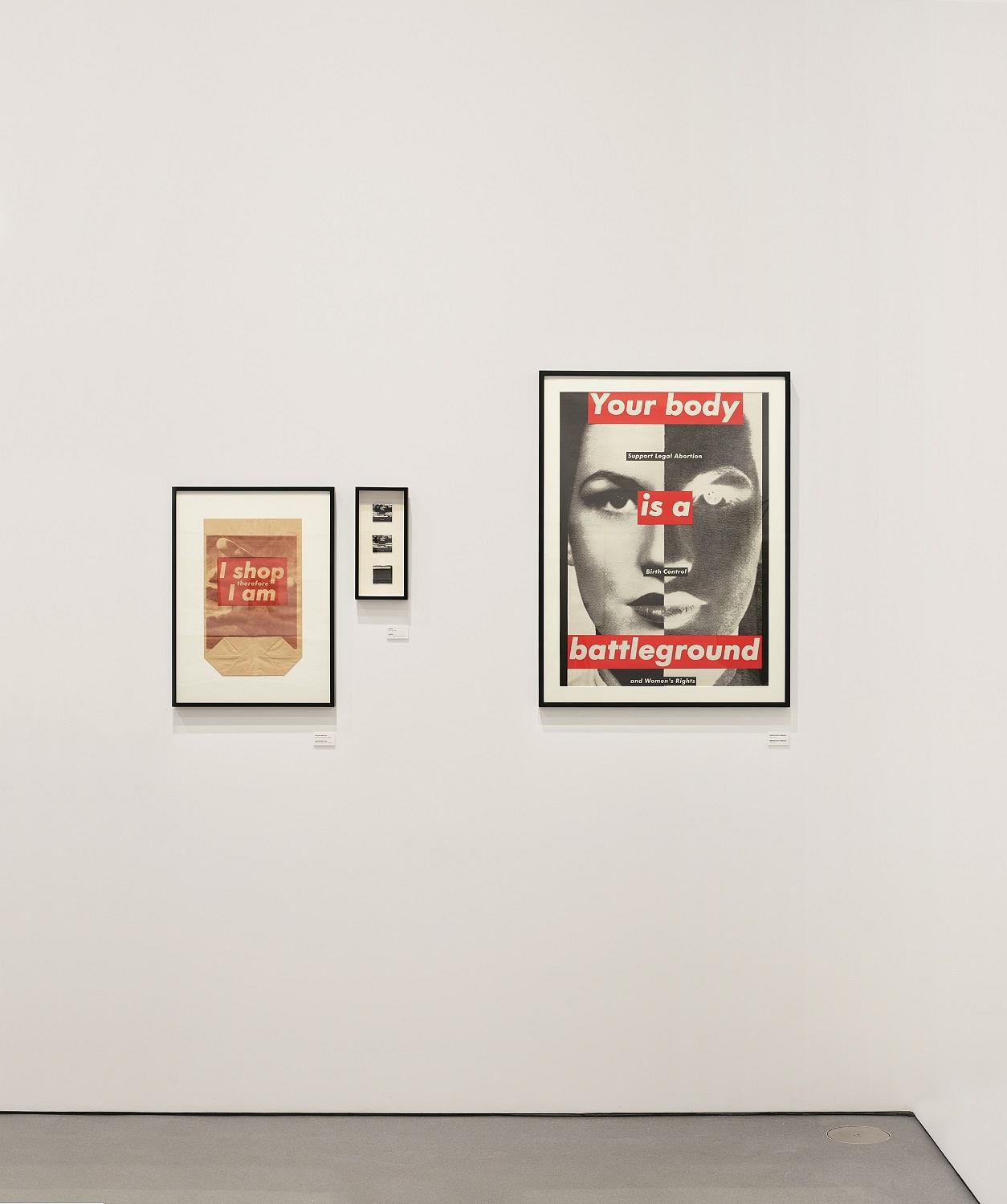
The exhibition installation: view of Barbara Kruger: Forever at the Amorepacific Museum of Art, Seoul, South Korea, 27 June–29 December 2019.
From poster to work of art
Fred Hoffman: In 1989, I organised a Barbara Kruger exhibition in my gallery in Santa Monica which included a huge, nine-foot-by-nine-foot photographic silkscreen-on-vinyl version of “Your Body Is a Battleground”. Barbara had removed all the text advertising the women’s march in Washington DC from the original poster design and left only the core message: “Your body is a battleground”. She understood how to transform the poster into a timeless work of art with continuing relevance. Before the exhibition actually opened, the piece was bought by Eli Broad, one of the most active and important collectors in Los Angeles, who was already committed to Barbara’s work.
Barbara Kruger: Eli Broad was one of the first collectors to support me. He bought my work in the very beginning, when I wasn’t a proper name. This was especially important to me because I’m not a painter and I wasn’t making art that was considered heavily investable at the time. So I knew that the support was based on the meaning that the work was trying to make.
Joanne Heyler: Since the Broad museum opened in 2015, Barbara’s “Untitled (Your Body Is a Battleground)” has been on permanent display. Last year, pre-pandemic, we had more than 900,000 visitors, which for a museum of our size in Los Angeles is a fairly big number. And our audience is about 70 per cent non-white, with an average visitor age of 33, 10 years younger than the average age of museum visitors in the United States. So I think these factors have contributed to the work’s increased social media presence.
Robyn Farrell: I have seen an uptick of “Your Body Is a Battleground” on my social media feeds since 2016 when Trump was elected, and then again with the Kavanaugh hearings.
Iwona Blazwick: There’s a generation of young women and men now who are connecting with “Your Body Is a Battleground”, partly because of the #MeToo and Black Lives Matter movements.
Joanne Heyler: We produce T-shirts and other merchandise, like postcards, hoodies, facemasks, with the artwork in collaboration with Barbara. We thought the T-shirt would be something that we’d have for a while and then retire as a product. But we’ve continually recreated it. It is our best-selling T-shirt ever.
Robyn Farrell: I think sometimes people know that image and that iconic battle cry before they may even know who Barbara Kruger is.
Shepard Fairey: Kruger is one of those rare people who can be held in high regard in the very elite art world in a museum context and also be recognised by a less art-world-fluent audience. And I really appreciate that and emulate it. Without Kruger I just wouldn’t be the artist I am.
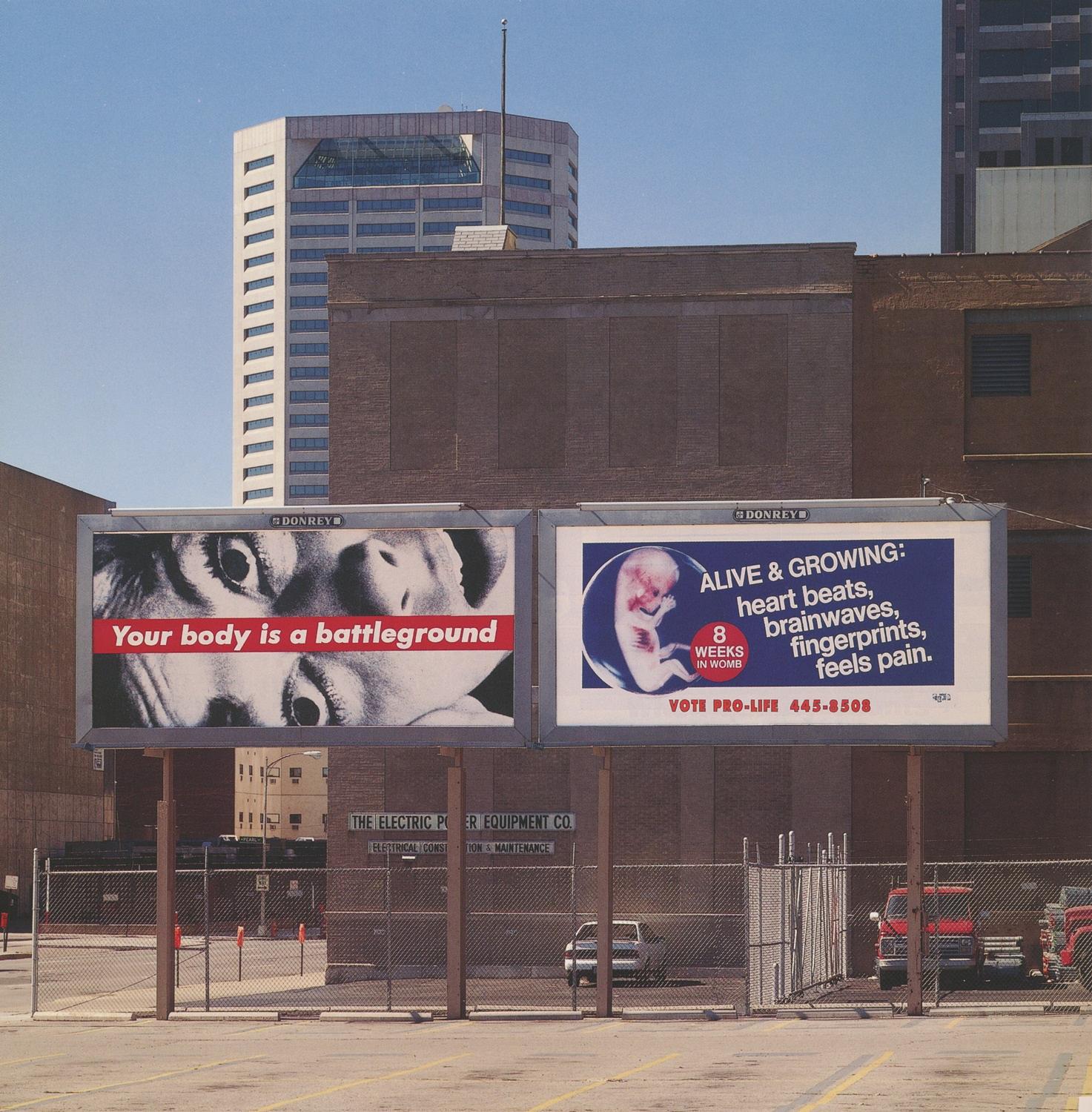
The hoarding: “Untitled (Your Body Is a Battleground)” billboard project with the Wexner Center for the Arts, Columbus, Ohio, 1990.
Language and legacy
Barbara Kruger: I consider the work very open-ended, and I don’t like to pin down meanings too much because it deadens the possibility of other interpretations.
Vince Aletti: I hate titles on photographs and most contemporary art, so when artists like Barbara Kruger, Cindy Sherman and Richard Prince started using “Untitled” it was kind of a relief. In Barbara Kruger’s case it hardly mattered, since the works ended up being called by their slogans anyway.
Rebecca Morse: Barbara’s use of the word “body” was prescient. Today we talk about female bodies and Black and brown bodies. Social scientists started using the term to show that racism and sexism is a physical issue.
Iwona Blazwick: The use of the word “battleground” was also significant, implying that something is being played out, that there’s one force against another. The idea of the assault on the body, which had been used in the discourse around abortion — she just turned that upside down to say, “No, you women, you’re the ones who are under assault.” As usual with Barbara, she uses something incredibly simple as a slogan, but it reverberates in unexpected ways.
Cindy Sherman: Because we’re still dealing with and having to fight for our reproductive rights, among other things.
Elizabeth Nash: The Supreme Court has shifted right — five out of the current nine justices do not support abortion rights — and legislators in states like Alabama, Ohio, Mississippi and Louisiana have responded by passing comprehensive abortion plans that permit bans after six or eight weeks of pregnancy, or in some cases total bans.
A new version
Robyn Farrell: Throughout her career, Barbara has consistently remade her work. She will distil the same image or text, or a combination of the two, and it may go from a small collage into a very large black-and-white vinyl with red frame, to wrapping the facade of a building, to a billboard and so on. The crux of our show is Barbara rethinking and remaking her work. It will include a new LED video version of “Your Body Is a Battleground”, which uses a variety of new texts. She has animated an iconic work with new associations for the 21st century, so she is looking back and looking forwards at the same time.
Rebecca Morse: The new texts in the video version include “Your Neck Is Squeezed” and “Your Skin Is Sliced”. She wrote those in 2019, but they have prefigured so many issues and events that are defining our current moment.
Barbara Kruger: Except for doing the original poster of “Your Body Is a Battleground” and a few other examples, my work tends not to be event-driven. I have power in mind, always. Power and how that plays out on our bodies, which are defined simultaneously through race and class and gender. The exhibition at the Art Institute of Chicago is not a retrospective. It’s really about how images change through time, through internet culture, how memes work, and it’s also a critique of what makes something “iconic” and how art is remade by its spectators.
Speakers
(in order of appearance)
Barbara Kruger, artist
Cindy Sherman, artist
Iwona Blazwick, director, Whitechapel Gallery, London
Elizabeth Nash, interim associate director of state issues, Guttmacher Institute
Vince Aletti, photography critic
David Crowley, design historian
Shepard Fairey, artist and graphic designer
Monika Sprüth, art dealer, co-founder of Sprüth Magers
Philomene Magers, art dealer, co-founder of Sprüth Magers
Robyn Farrell, assistant curator, Art Institute of Chicago
Fred Hoffman, art dealer,
Joanne Heyler, founding director, the Broad, and chief curator, the Broad Art Foundation, Los Angeles
Rebecca Morse, curator of photography, Los Angeles County Museum of Art, Santa Monica, California
Milada Ślizińska, chief curator for foreign exhibitions, Ujazdowski Castle Centre for Contemporary Art, Warsaw, 1990–2011
